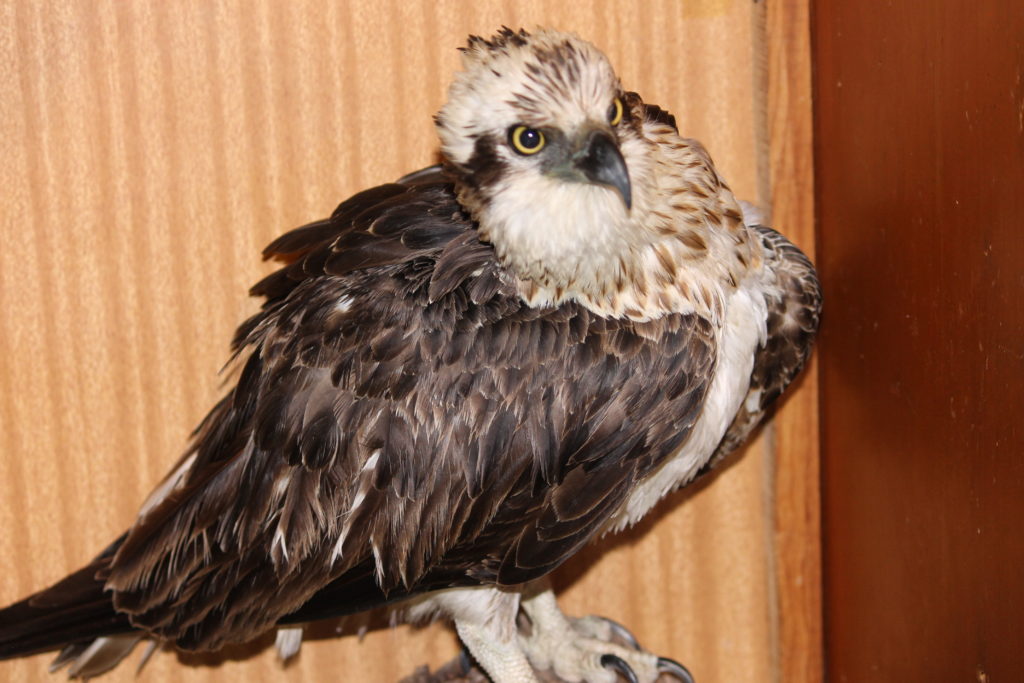
Wildlife Notes
Private Wildlife Magazine 2013/14
Operation Osprey Rescue Story
I was delighted to join other rescuers to record the release of a magnificent, but slightly unusual, osprey at a nearby Oval. We eagerly anticipated that heart-soaring moment: when a bird that’s been in care is ready for release and flies away, fit strong and keen to return to the wild.
The Eastern Osprey: that sovereign of nature! (Well, there’s always an exception to the rule.)
Stephen Debus’ Birds of Prey Australia describes: A ‘solitary hawk…with kite-like flight and buoyant with shallow, gentle rhythmic wing-beats; soars and glides on bowed wings…’
(Usually. It’s all a matter of confidence.)
The osprey eats mostly fish: ‘…It dives headlong into the water with the feet thrown forward, submerging in a plume of spray with the wings raised…’
(But how does it get itself out of the water?)
For this young osprey the whole fishing and flying stuff just wasn’t going to plan. Left to his own devices, the only fish dinner he was likely to enjoy would be from the chip shop.
We carefully lifted him from the box, he looked every inch the powerful, competent prince of his environment. He recognized his home. Way up, on top of the pole, was the nest he’d hatched in. His mother took off and flew around for a while before she headed out to Lake Macquarie. With a gentle, firm lift from gloved hands he was off!
We watched with wonder and pride of a job well done.
The majestic bird flew straight to his nest. This is where it all started to go wrong. Again. As he landed on the edge of the nest, he startled his sibling. With a screaming squawk and beak-thrust from his unimpressed sister, our poor Prince did not get the homecoming he’d expected. His sister was seriously scary! Without even a fair chance to get back into the nest, he launched himself away from the bully within.
At this point, the local feathered gang added to our noble Prince’s humiliation. Size means nothing if self-confidence is lacking. He was chased away from his home by mobbing mynahs.
We willed him to stand (fly) up for himself and declare his right to the throne; but he just kept going…even after the mynahs had become bored and returned to their tree on the other side of the Oval with smug and raucous satisfaction. Once he’s settled and regained confidence in himself, he’ll fly back. Or so we thought. He was free.
About twenty minutes later, as we grabbed a quick coffee, the rescue hotline phone rang.
“He’s back in the water”.
What was it with this bird? Some sort of duck complex? Why didn’t he know he was supposed to do all that poetic stuff eagles do? Frankly, I thought this ‘Bird of Prey’ was being a bit of a Tit.
Once more, the bedraggled bemused (and dethroned) Prince was heading back to one of the senior raptor carers. If he weren’t able to return to the nest soon he’d have little chance of being allowed back. If he were released without being able to fish for himself, he’d have no chance of survival.
We had real concerns for the bird’s welfare, and began investigating. My friend, senior raptor handler, told me that she thought there might be a problem with the natural preening function of oil to his feathers. A diving bird without waterproofing? That’s what it looked like.
Preening has two functions:
One is to maintain the correct alignment of the layer of contour feathers to ensure all interlocking barbules are in place;
The second is to spread secretions onto the feathers. Without an efficiently-functioning uropygial gland (preen gland) and structure integrity of the barbules, the feathers can lose their natural water repellent properties.
This was indeed the case with our sinking Prince. There followed several phone calls to specialist wildlife/seabird Veterinarians, which resulted in some pretty intricate surgery for the young bird.
Happily, some weeks after his first rescue, this White-Bellied Sea Eagle was successfully released.
As far as we know, he hasn’t sunk again…